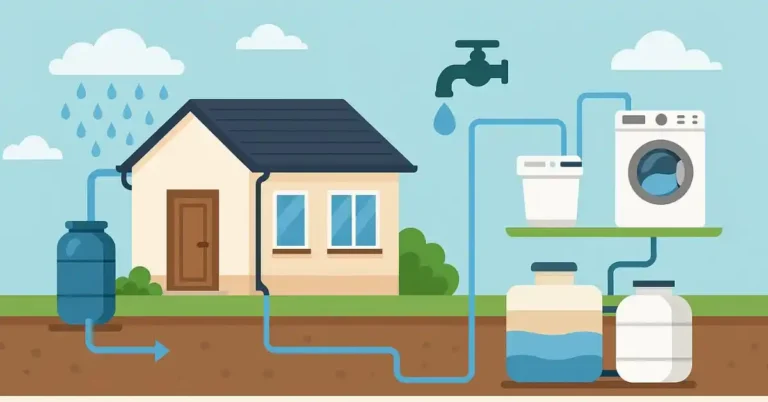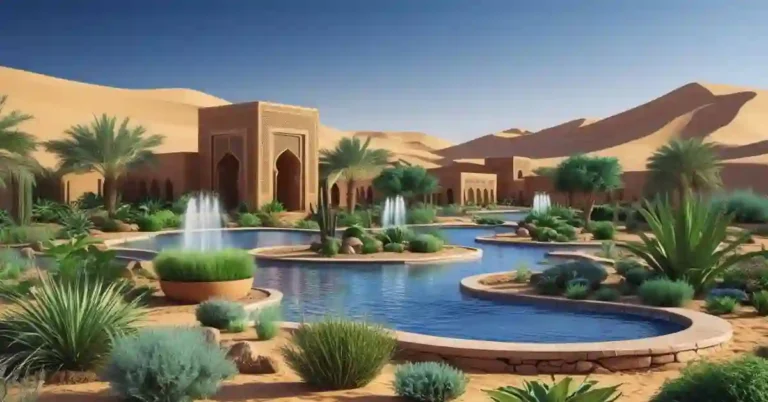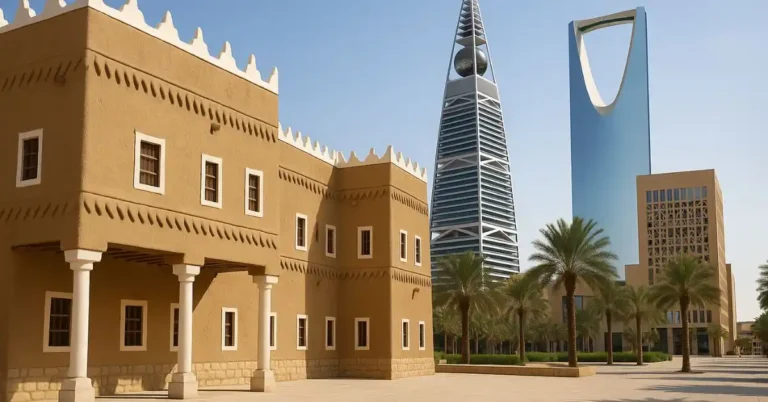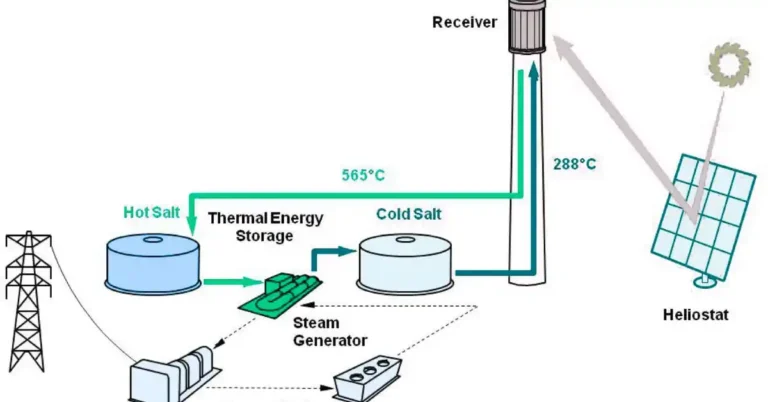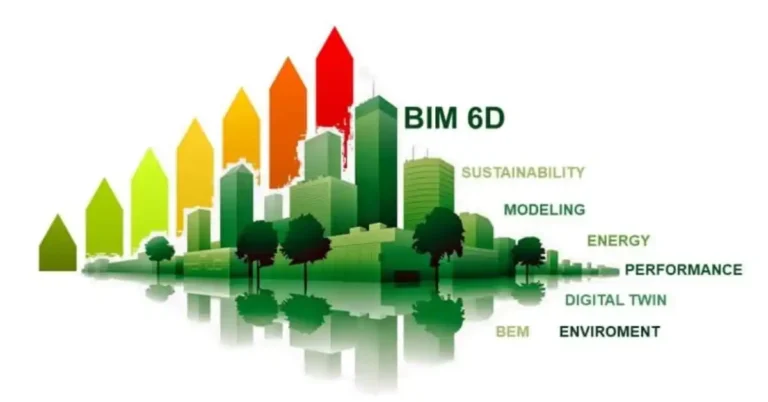Passive Design Strategies For Cooling Buildings Naturally in KSA
In the scorching desert climate of Saudi Arabia, where summer temperatures regularly soar above 45°C, keeping buildings cool has traditionally relied on energy-intensive air conditioning systems. This approach has led to Saudi Arabia becoming one of the world’s highest per capita energy consumers, with residential buildings accounting for over half of the nation’s electricity consumption.
Remarkably, cooling demands alone are responsible for more than 70% of this residential energy use, creating both economic and environmental challenges for the Kingdom. As Saudi Arabia advances its Vision 2030 sustainability goals and faces the reality of climate change, passive design strategies offer a compelling alternative working with nature rather than against it to maintain comfortable indoor environments while dramatically reducing energy consumption.
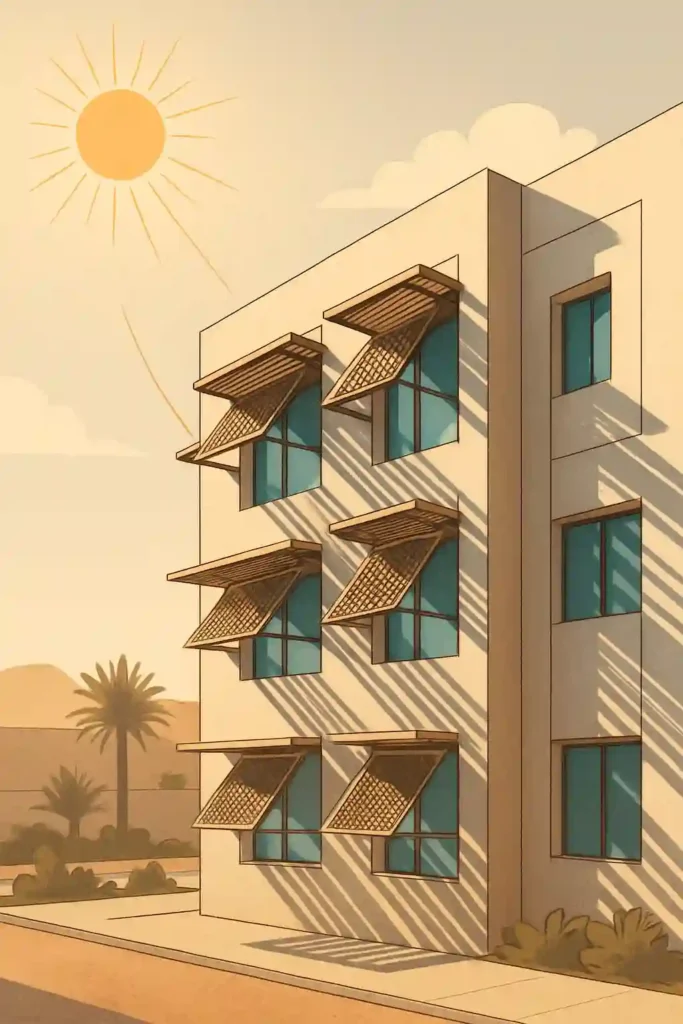
These strategies, many rooted in traditional Arabian architectural wisdom but enhanced with modern innovations, represent a crucial pathway toward sustainable development in the region. This comprehensive guide explores how passive design strategies can be effectively implemented in Saudi Arabia’s unique climate conditions.
From ancient wind towers to cutting-edge thermal insulation, from strategic building orientation to innovative shading solutions, we’ll examine the full spectrum of natural cooling techniques that can transform how buildings perform in the Kingdom’s challenging environment.
Research demonstrates that properly implemented passive design approaches can reduce cooling energy demands by up to 68% compared to conventional buildings a game-changing potential for a nation where air conditioning currently dominates energy usage.
Whether you’re an architect, builder, homeowner, or policy maker, understanding these passive cooling strategies offers valuable insights into creating more sustainable, comfortable, and economical buildings in Saudi Arabia’s hot arid climate.
Let’s explore how traditional wisdom and modern innovation can combine to keep buildings naturally cool in one of the world’s most challenging thermal environments.
Understanding Saudi Arabia’s Unique Climate Challenges
Saudi Arabia presents one of the world’s most challenging environments for building design and thermal comfort. Spanning approximately 2.15 million square kilometers, the Kingdom experiences extreme climate conditions that make conventional cooling approaches both energy-intensive and environmentally problematic.
Climate Extremes Across the Kingdom
The climate of Saudi Arabia is predominantly characterized by its hot, arid desert conditions, though there are significant regional variations. In Sharurah, located at the edge of the Empty Quarter desert, summer temperatures regularly range from 27.8°C to a scorching 46.1°C.
This city experiences some of the highest daily solar radiation levels in the entire Kingdom, exceeding 6.7 kWh/m²/day. Such intense solar exposure creates enormous cooling challenges for buildings, as external surfaces can reach temperatures well above 60°C during peak summer days.
In the central regions around Riyadh, summer daytime temperatures typically range between 40-45°C, while coastal cities like Jeddah experience slightly lower temperatures but significantly higher humidity levels, creating different cooling challenges.
The annual relative humidity across the Kingdom varies dramatically, from as low as 9.3% in inland desert regions to nearly 90% in coastal areas during certain seasons. Rainfall is exceptionally scarce throughout most of Saudi Arabia, with average annual precipitation in many regions below 100mm.
Sharurah, for example, receives an average of just 70.29mm annually. This lack of rainfall contributes to the extreme aridity that characterizes the region and limits natural cooling options that might be available in more temperate climates.
Solar Radiation and Its Impact on Buildings
The intensity of solar radiation in Saudi Arabia creates particular challenges for building design. With clear skies predominating throughout most of the year, direct solar radiation becomes the primary source of heat gain in buildings. This radiation not only heats external building surfaces but also penetrates through windows and other openings, creating significant internal heat loads.
Studies have shown that unshaded southern façades in Saudi Arabia can experience temperature increases of up to 3°C during summer months compared to properly shaded equivalents. The low angle of the sun during morning and afternoon hours means that east and west-facing surfaces receive particularly intense radiation, making orientation and shading critical considerations in passive design.
The Economic and Environmental Cost of Conventional Cooling
The reliance on mechanical air conditioning in Saudi Arabia has led to staggering energy consumption patterns. According to the Saudi Electricity Company, the residential sector alone consumes approximately half of the country’s total electricity production, with air conditioning accounting for 70% of this residential consumption.
In the Southern Operating District, residential consumption reaches an astonishing 67% of total electricity use. This heavy dependence on mechanical cooling has significant economic implications. The annual primary energy consumption per capita in Saudi Arabia has increased dramatically from 3.88 to 9.14 MWh between 1980 and 2014.
This trend has continued, placing enormous pressure on the nation’s energy infrastructure and contributing to its status as the second-largest energy consumer in the Gulf region and the eleventh globally.
The environmental impact is equally concerning. The carbon footprint associated with this energy consumption contributes significantly to greenhouse gas emissions, while the heat rejected from air conditioning systems creates urban heat islands that further exacerbate cooling demands in densely built areas.
Climate Change Projections and Future Challenges
Climate change projections suggest that Saudi Arabia will face even more extreme conditions in the coming decades. Global temperature rise projections of up to 1.5°C by the early 2030s will likely manifest even more severely in desert regions like Saudi Arabia.
This warming trend will further increase cooling demands, potentially creating a vicious cycle of increased energy consumption and environmental degradation unless alternative approaches are implemented.
The combination of rising temperatures, increasing urbanization, and growing population places Saudi Arabia at a critical juncture regarding building design and cooling strategies. Passive design approaches that work with the local climate rather than against it represent not just an environmental choice but an economic necessity for the Kingdom’s sustainable development.
Traditional Arabian Architecture: Time-Tested Cooling Wisdom
Long before the advent of modern air conditioning, the Arabian Peninsula developed sophisticated architectural solutions to combat the extreme desert heat. These traditional approaches, refined over centuries, offer valuable insights for contemporary passive design in Saudi Arabia.
The Wisdom of Wind Towers (Malqaf)
Perhaps the most iconic element of traditional Gulf architecture is the wind tower, known locally as “malqaf” or “barjeel.” These tall, chimney-like structures capture passing breezes and funnel them down into the building interior. The design creates a natural pressure differential that drives air circulation even when external winds are minimal.
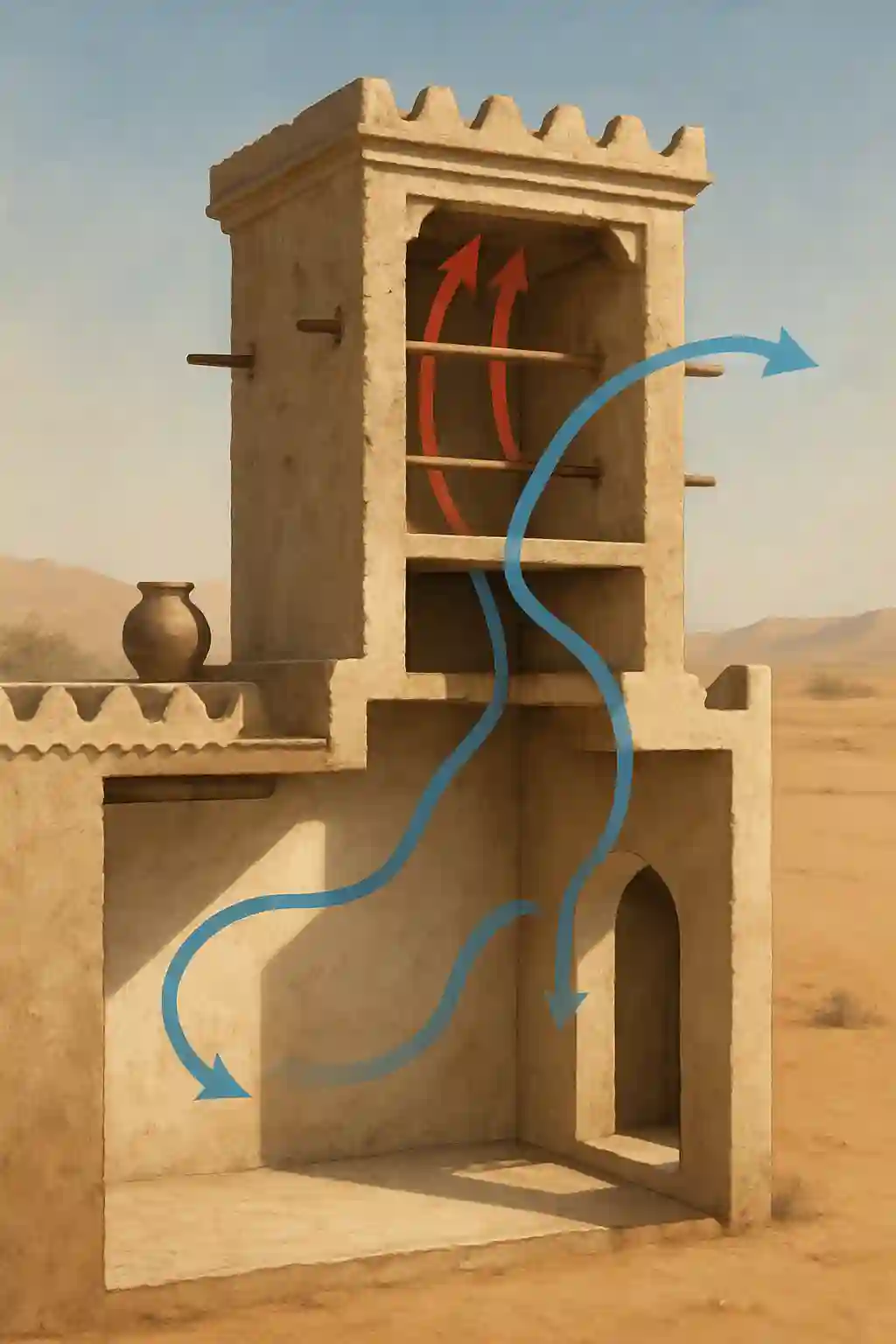
Traditional wind towers in the Arabian Peninsula typically featured openings oriented toward the prevailing wind direction. As air enters the tower, it’s often passed over water features, creating evaporative cooling that can reduce air temperature by 13-16% before it enters living spaces.
This ancient technology demonstrates a sophisticated understanding of thermodynamics and fluid dynamics that predates modern engineering by centuries. Modern adaptations of wind towers incorporate contemporary materials and design refinements while maintaining the core passive cooling principles.
Research conducted at Saudi universities has demonstrated that properly passive design straegies contemporary wind towers can reduce indoor temperatures by 8-10°C compared to outdoor conditions without any mechanical assistance, representing a significant opportunity for passive cooling in modern buildings.
Courtyard Passive Design Strategies: Microclimate Creation
The traditional courtyard house (known as “sahn” or “hoash”) represents another masterful response to desert conditions. These inward-facing designs create a protected microclimate that moderates temperature extremes through several passive mechanisms:
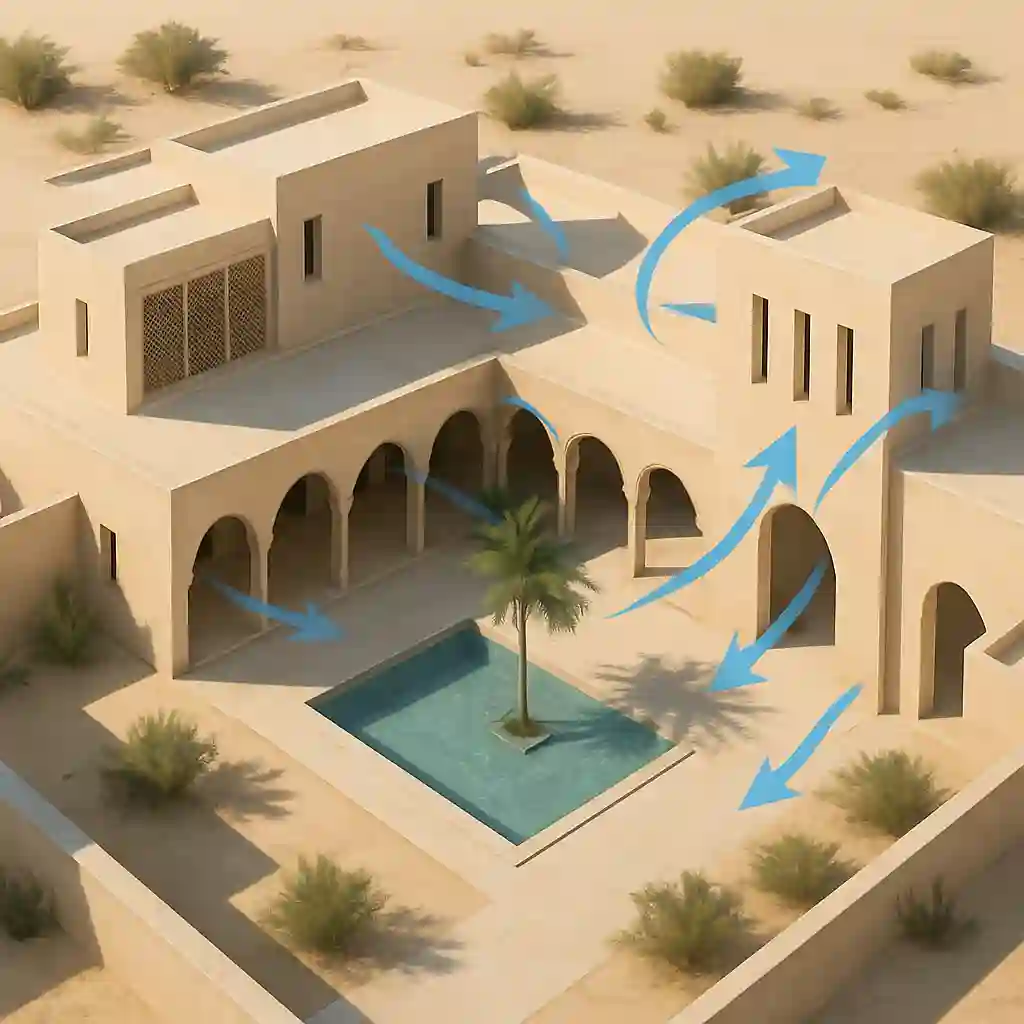
1.Thermal buffering: The courtyard acts as a thermal buffer zone between the harsh external environment and interior living spaces.
2.Stack effect ventilation: As the sun heats the courtyard during the day, warm air rises, creating natural convection currents that draw cooler air through surrounding rooms.
3.Night cooling: At night, the courtyard radiates heat to the clear desert sky, becoming a cool air sink that provides natural cooling to adjacent spaces.
4.Evaporative cooling: Water features and vegetation in courtyards increase humidity and reduce air temperature through evaporation.
Studies of traditional courtyard homes in Saudi Arabia have shown temperature differentials of up to 15°C between the courtyard microclimate and surrounding streets during peak summer conditions. This significant cooling effect was achieved without any mechanical systems, relying solely on architectural passive design strategies and natural processes.
Material Wisdom: Thermal Mass and Natural Insulation
Traditional Arabian architecture made strategic use of locally available materials with properties ideally suited to the desert climate:
Thick earthen walls: Adobe, mud brick, and rammed earth construction provided substantial thermal mass that absorbed heat during the day and released it slowly at night, moderating indoor temperature fluctuations. These walls, often exceeding 50cm in thickness, created a thermal time lag of 8-12 hours, effectively shifting the heat load to nighttime when outdoor temperatures were lower.
Natural insulation: Materials like palm fiber, wool, and reed were incorporated into roof constructions to reduce heat transfer. These natural insulators, combined with air gaps and ventilated roof spaces, significantly reduced solar heat gain through what would otherwise be the most exposed building surface.
Reflective surfaces: Traditional buildings often featured light-colored, sometimes whitewashed exterior surfaces that reflected solar radiation rather than absorbing it. This simple but effective strategy reduced surface temperatures by up to 20°C compared to darker finishes.
Mashrabiya: The Original High-Performance Window
The mashrabiya an ornate wooden lattice screen represents one of the most sophisticated elements of traditional Arabian architecture. Far more than decorative, these screens served multiple functions:
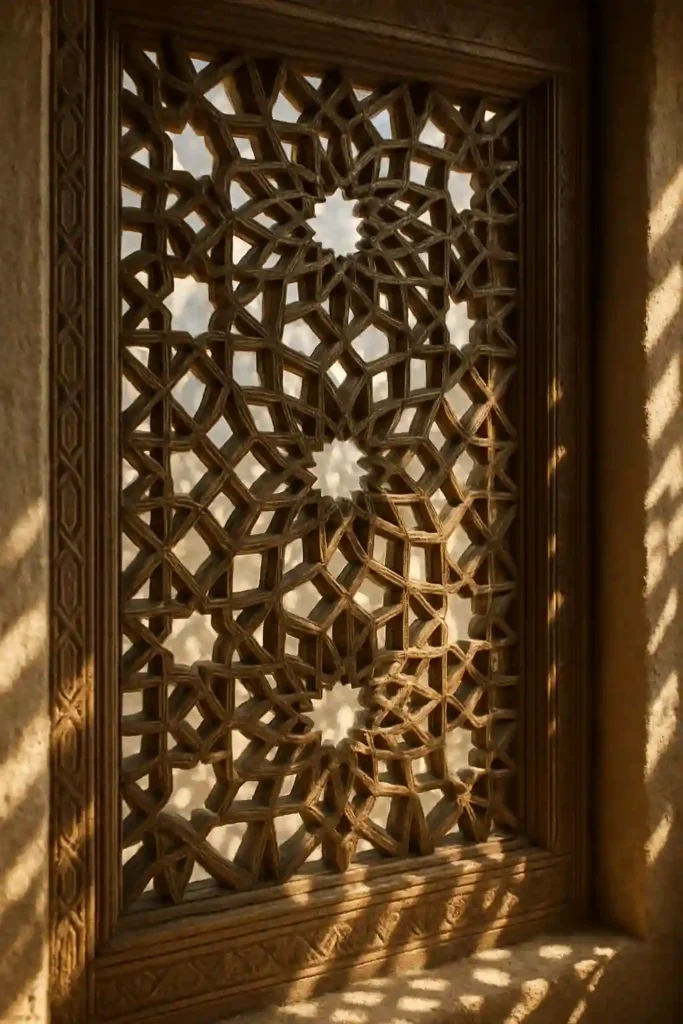
1.Solar control: The geometric patterns were carefully designed to block direct sunlight while allowing diffuse daylight to enter interior spaces.
2.Privacy: The screens permitted occupants to view the street while preventing outsiders from seeing in.
3.Air flow modulation: The wooden lattice filtered and directed air movement, enhancing natural ventilation.
4.Evaporative cooling: In some passive design strategies, clay water vessels were placed within the mashrabiya, cooling incoming air through evaporation.
The intricate geometric patterns of mashrabiya were not arbitrary but represented sophisticated solar passive design strategies that responded to the sun’s changing angles throughout the day and seasons. Modern computational analysis has revealed that traditional mashrabiya designs achieved near-optimal balance between daylighting, ventilation, and solar control—a remarkable achievement considering they were developed through empirical observation rather than scientific calculation.
Lessons for Contemporary Passive Design Strategies
These traditional approaches offer valuable lessons for contemporary passive design in Saudi Arabia. While modern buildings have different functional requirements and utilize different materials, the underlying principles of these time-tested strategies remain valid:
1.Harness natural air movement through Passive design strategies elements 2.Create protective microclimates through courtyard and atrium designs 3.Utilize thermal mass to moderate temperature. 4.Employ sophisticated shading that responds to solar geometry 5.Integrate evaporative cooling where appropriate
By understanding and adapting these traditional techniques, contemporary architects and builders can create buildings that respond harmoniously to Saudi Arabia’s challenging climate while significantly reducing energy demands for cooling.
Modern Passive Cooling Strategies for Saudi Arabian Buildings
While traditional Arabian architecture offers valuable lessons in passive cooling, contemporary building science has developed advanced strategies that can be specifically tailored to Saudi Arabia’s extreme climate conditions. These modern approaches combine time-tested principles with innovative materials and technologies to create high-performance building envelopes that significantly reduce cooling demands.
Thermal Insulation = Your First Line of Defense
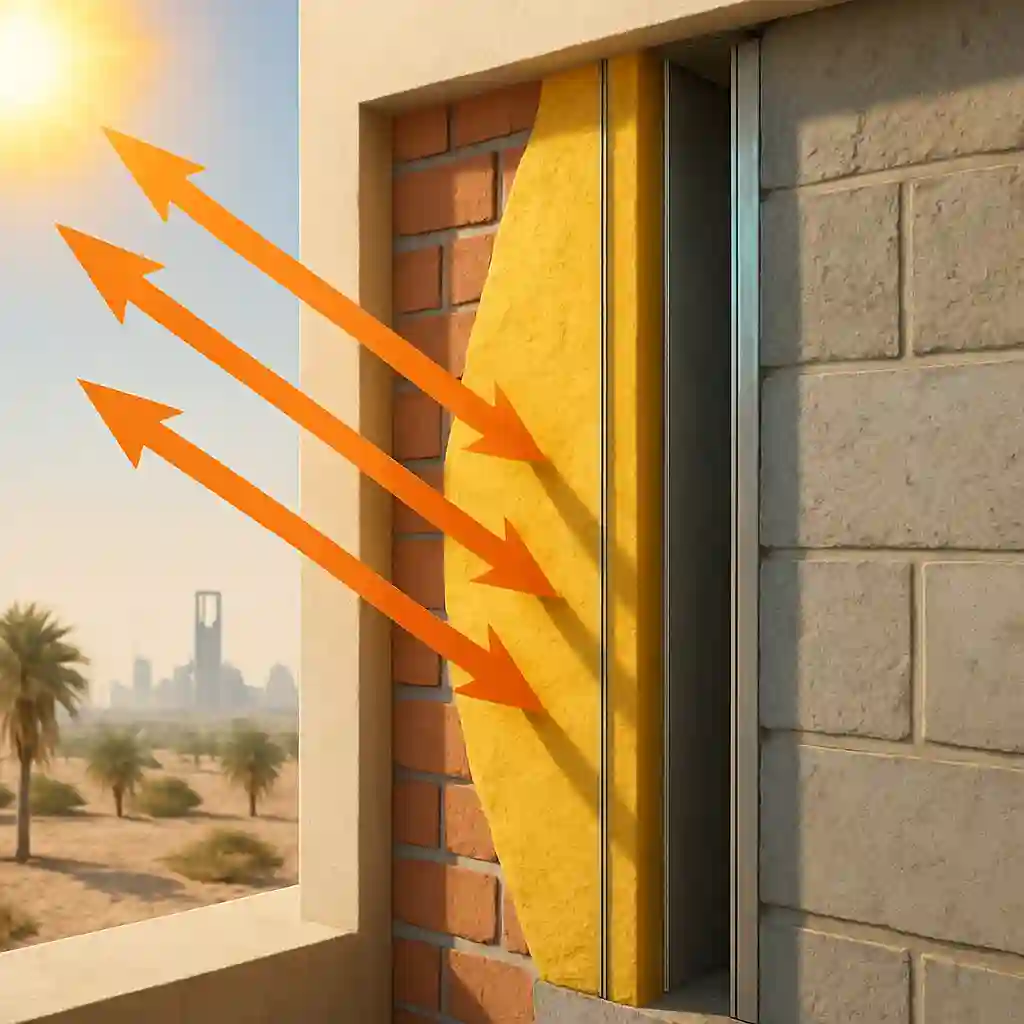
In Saudi, we’re not keeping heat in — we’re keeping it out.
✅ Best move? Put insulation outside the concrete walls. Keeps the mass cool and interior comfy.
✅ Reflective insulation (like shiny radiant barriers) is a must for roofs baking in the sun.
✅ Wanna get fancy? Phase-change materials soak up heat during the day and release it at night — super smart cooling trick!
And guess what? Doing this right can cut annual energy use by up to 23.6%. Not bad, huh?
Strategic Shading = Free Sunblock for Buildings
No one wants direct sun blasting their walls and windows all day.
✅ Go for external shading that moves with the sun (automated is best).
✅ Or use fixed shading — overhangs, mashrabiya-style screens, or vertical fins — just size them based on your location’s sun angles.
✅ Plants help too! Think native trees, drought-proof shrubs — east & west sides especially.
Add all this up, and shading can slash your cooling load by up to 37% when paired with other passive tools!
Green Roofs = Nature’s AC
Yes, you can have plants on your roof in Saudi. And they do wonders.
✅ They act like thermal insulation and cool through evaporation — dropping rooftop temps by up to 40°C!
✅ They also protect your roof from sun damage = longer lifespan.
✅ Just use smart passive design strategies with native, low-water plants and gray water irrigation if possible.
Result: 5–7°C cooler rooms under the green roof!
Glazing Upgrades = Big Impact from Little Panels
Your windows can be the weak link — or a strength:
✅ Use spectrally selective glass — lets in light, blocks heat.
✅ Or go high-tech: electrochromic glass tints itself automatically.
✅ Even better? Vacuum glazing or solar glass that generates electricity while keeping heat out.
This may only cut 3–5% of cooling needs, but that’s still a huge chunk of energy in Saudi’s climate!
Wrap-up: Layer these passive strategies like armor — insulation, shading, green roofs, and upgraded glazing. Each one plays its part, and together, they can transform your building into a cool, comfortable, and energy-efficient oasis in the desert
Optimizing Building Orientation and Design in Hot Arid Climates
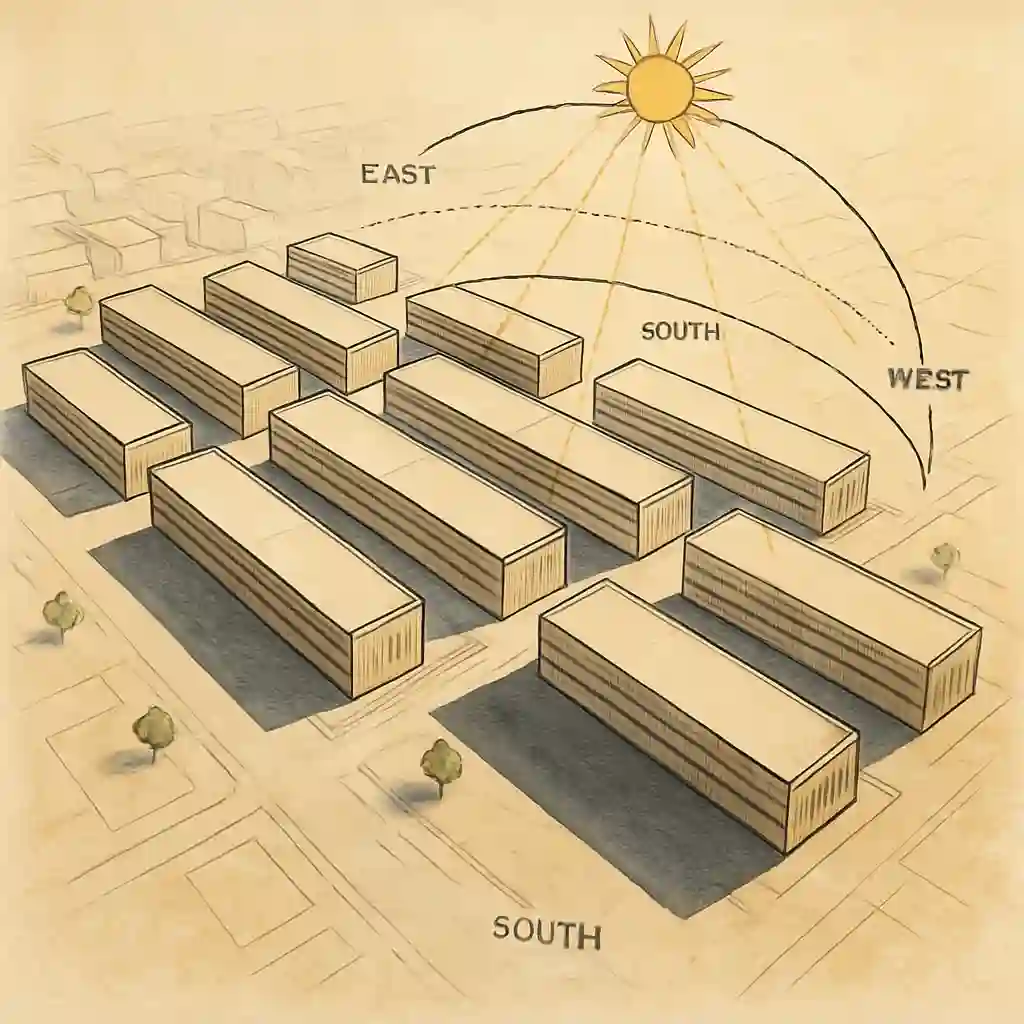
Building orientation and overall passive design strategies form the foundation of effective passive cooling strategies in Saudi Arabia. These fundamental decisions, made early in the design process, can dramatically impact a building’s thermal performance and determine the effectiveness of all other passive cooling measures.
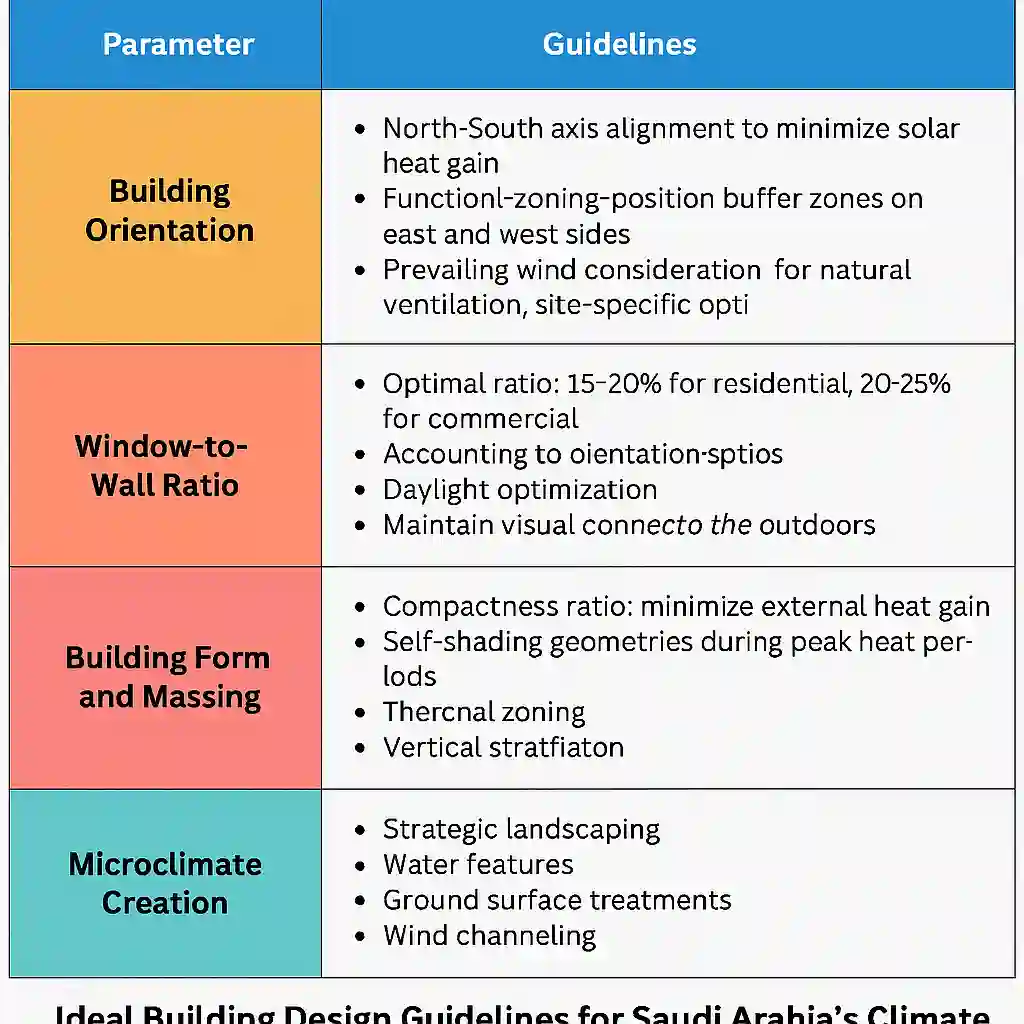
Natural Ventilation Techniques for Saudi Arabian Homes
Natural ventilation represents one of the most energy-efficient passive cooling strategies available for buildings in Saudi Arabia. When properly passive design strategies and implemented, these techniques can significantly reduce or even eliminate the need for mechanical cooling during milder seasons while complementing air conditioning during extreme periods.
Cross Ventilation
Think wind blowing straight through your house. It works best when openings are directly across from each other.
✅ Inlet captures wind, usually from the north/northwest, and outlet lets it out.
✅ Outlet should be 25-30% bigger than inlet for that turbo airflow.
✅ Interior spaces? Keep ‘em open or at least aligned with the wind—not blocking it.
Proper cross-ventilation can cool a building by 3–5°C during mornings/evenings. That’s without any machines running!
Night Purge Ventilation
Let your house “breathe” at night.
✅ Use cooler outdoor air to flush out daytime heat.
✅ Let that airflow hit exposed thermal mass—bare concrete floors and walls, not carpets.
✅ Use smart sensors or fans to automate when windows/vents open and close.
✅ Security? Install secure vents or louvers so air flows without inviting intruders.
This can lower peak temps next day by 4–7°C!
Wind-Driven Systems
Modern wind towers and scoops are the high-tech version of traditional malqaf.
✅ They pull in wind from rooftops or walls.
✅ Some even combine solar chimneys for stack effect when wind is low.
✅ Use roof shapes or venturi-like features to boost airflow with style.
These can cool rooms by 6–8°C, proven in local university research!
Hybrid Ventilation = Best of Both Worlds
Sometimes, nature needs a little help. So we blend systems:
✅ Let nature work when it can, switch to AC when it must.
✅ Ceiling fans give a 3–4°C cooling sensation using just pennies of power.
✅ Use evaporative cooling (especially in dry regions) to pre-cool fresh air.
✅ Even earth tubes—air runs through underground pipes and enters cooler.
The result? 40–60% less AC usage and year-round comfort.
Thermal Mass and Material Selection for Passive Cooling
Here is a concise detailed content on Thermal Mass and Passive Cooling Strategies in Saudi Arabia:
| Aspect | Key Insight |
|---|---|
| Climate Relevance | Saudi Arabia’s hot, dry climate benefits from thermal mass + passive design strategies for stable indoor temps. |
| Best Thermal Mass Materials | Concrete, stone, brick – high density + heat capacity = optimal time lag (8–12 hrs). |
| Clay Bricks | 16–25% more efficient than concrete/lime; hygroscopic + locally available; delays heat transfer. |
| Modern Materials | PCMs, TABS, water walls, composite layers enhance performance with reduced mass and high capacity. |
| Best Integration | Combine mass with night ventilation, shading, insulation, and evaporative cooling. |
| Energy Savings | 30–45% cooling energy reduction via combined passive strategies. |
| ROI Payback | 3–7 years for insulation, glazing, shading; 8–10 yrs for green roofs. |
| Case Study Results | Real projects show 30–45% less cooling energy (e.g. KAUST, KAFD, Al Nakheel). |
| Retrofit Potential | Existing buildings can save 25–40% by enhancing mass, shading, airflow, and envelope. |
| Government Support | Tarshid, Vision 2030, SEEC, and SGBF offer funding, codes, and incentives for passive design. |
Conclusion:
Passive design strategies in Saudi Arabia is a vital step toward sustainability, efficiency, and cultural continuity. It can reduce energy use by up to 68% while enhancing comfort and building performance. Drawing from traditional wisdom and modern innovation, passive strategies suit the Kingdom’s climate. Though initial costs may be higher, payback in 4–7 years and long-term savings make it worthwhile.
These approaches align with Vision 2030 by conserving energy and reducing carbon emissions.
Now is the time to embrace passive cooling as a core principle, not an optional choice.
